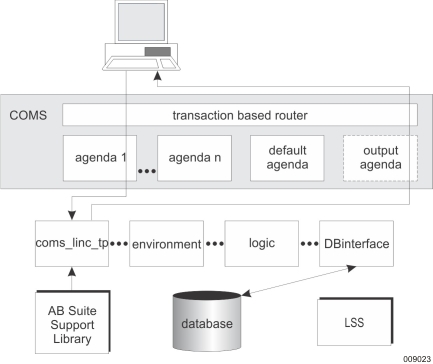
Standard Message Routing
Agile Business Suite standard message routing is depicted above. This process is summarized as follows:
Input is routed by Transaction Based Routing (TBR) to a copy of the appropriate COMSTP program.
The COMSTP program locates the station GLB-DIALOGINFO record (or creates one, if this is the first message for this station), using a unique key assigned to the station name and COMS dialog number combination. For greater efficiency, GLB-DIALOGINFO is set up as a DMS II Direct dataset.
If the Preserve Session Data Segment configuration property is set to False for the application, the GLB-DIALOGINFO records (other than those created by the first message for each station) are retained in memory, rather than in the database.
The LINCSUPPORT library is called once for each message, to obtain:
Glb.Unique value
Station number
Last error (recovery)
Last subsystem (requirement for SPCFY key)
Host name
If it is the first message for a station since the application was initiated, the COMSTP program obtains the station name and station attributes (type, privilege level, and so on) from the installation data that is loaded in the COMS configuration. This information is maintained in the LINCSUPPORT library.
Output identified as casual is sent when the SEND is executed; for example, with Message Immediate commands.
Message processing might then continue, up to the point of final output.
If logging is required, the logging library is called to record the input record initially and the output record on completion.
The final output is sent (after the END-TRANSACTION is completed), and the entire process might then be repeated for the next message.
You might optionally declare a COMS Output Agenda to post-process the output with a Processing Item routine. Assuming that your COMS Processing Item and Processing Item List exist, use COMS Utility to create an Agenda, defining:
Agenda name (any name you choose)
Window name for the application
Default Output Agenda (set to Y)
Processing Item List name
Note: Using System software facilities to manipulate Agile Business Suite message content outside of Agile Business Suite functionality (for example COMS PIs) is done at your own risk.
TRANCODE is a station attribute in COMS, and is assumed to be set to 1 (the first character of the message). This corresponds to the position of the <<Ispec>> class name on the top line of a screen.
Note: For IBM 3270 devices using BISYNC protocol and the LINC 3270 Formatting Library, the TRANCODE position must be defined as 7. (By default, the standard terminal Trancode position is 1.)
As Trancode is declared on a per-station basis, the positions of the T or N transaction source designation follow the <<Ispec>> class name on the top line of a screen.